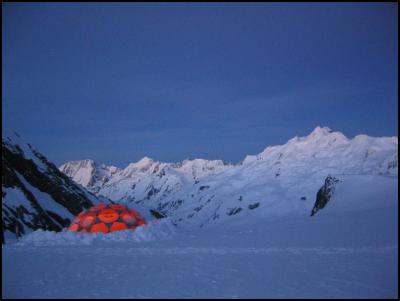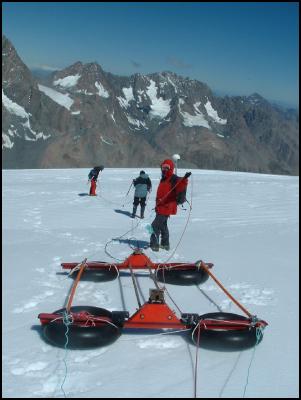Scientists To Drill For Ice Cores In Southern Alps
Media Release
10 June 2009
Scientists To Drill For Ice
Cores In Southern Alps Glaciers

Click for big version
Drill Tent With Mt Cook Behind

Click for big
version
Ice
Radar
Scientists from three
countries will camp out high in Mt Cook National Park for
the next three weeks collecting ice cores from glaciers for
climate research.
During daylight hours they will use a special drill with a hollow barrel to recover ice cores right down to the bedrock. After dark they will hunker down at high altitude in nylon tents built to Antarctic standards.
Daytime temperatures are expected to hover around zero degrees Celsius, and could go a low as minus 20deg at night.
Two New Zealanders, two Chinese and two Americans will be working in normally inaccessible parts of the National Park in a bid to get high quality ice cores for scientific analysis.
In spite of the harsh conditions, winter is the best time of year to drill to avoid the ice melting as it is brought to the surface.
Ice cores contain climate records that can date back hundreds of years. Annual layers in the cores enable scientists to extract information such as temperature, rainfall, wind speed, and the amount and type of atmospheric dust.
The information contained in the ice cores will help in understanding past climate patterns in the Southern Hemisphere.
Uwe Morgenstern of GNS Science is leading the project and manager of the expedition is Julian Thomson, also of GNS Science.
Mr Thomson said getting good ice cores from glaciers in the Southern Alps was a challenge.
“Ideal ice core sites are flat, at high altitude, with a slow-moving glacier and moderate snow accumulation. These sites have the best conditions to preserve a long and continuous record of annual ice core layers,” he said.
“Such sites are rare in the Southern Alps where the highest areas are typically steep and with very high snow accumulation rates. New Zealand glaciers are therefore fast moving and dynamic.”
Weather permitting, the scientists plan to retrieve ice cores from several sites with altitudes ranging from 2200m to 3000m.
The cores will be brought to the surface in 1m lengths, bagged in clear polythene and stored in purpose-built insulated boxes. Typically, it can take up to 12 hours to retrieve 50m of core from a site.
The ice cores will be air-lifted off the glacier and taken to Mt Cook Village and stored in a walk-in freezer at The Hermitage Hotel. From there a refrigerated truck will take them to the New Zealand Ice Core Research Laboratory at the National Isotope Centre, GNS Science, in Lower Hutt.
In recent weeks scientists from Victoria University of Wellington used ground-penetrating radar equipment to determine the ice depth, internal layering, and nature of the bedrock at the proposed drill sites.
Scientists estimate that glaciers in the Southern Alps have lost up to 60 percent of their ice volume since the 1850s.
Mr Thomson said as the glaciers continued to retreat, the climate records stored in the ice were at risk of deterioration.
END


 Alcohol Beverages Council: Turning The Tide - New Zealanders Unite To Curb Harmful Drinking
Alcohol Beverages Council: Turning The Tide - New Zealanders Unite To Curb Harmful Drinking University of Auckland Business School: Economists Urge Action To Prevent ‘AI Poverty Traps’
University of Auckland Business School: Economists Urge Action To Prevent ‘AI Poverty Traps’ Bill Bennett: Australian warship takes rural fixed wireless broadband offline
Bill Bennett: Australian warship takes rural fixed wireless broadband offline NZ Telecommunications Forum - TCF: New Zealand Is Saying Goodbye To 3G: Are You Ready For The Change?
NZ Telecommunications Forum - TCF: New Zealand Is Saying Goodbye To 3G: Are You Ready For The Change? NZ Post: Mānawatia A Matariki - NZ Post Stamps Look To The Stars Ahead Of The Māori New Year
NZ Post: Mānawatia A Matariki - NZ Post Stamps Look To The Stars Ahead Of The Māori New Year Waipa Networks: Cambridge Is Open For Business With $45M Energy Boost
Waipa Networks: Cambridge Is Open For Business With $45M Energy Boost


